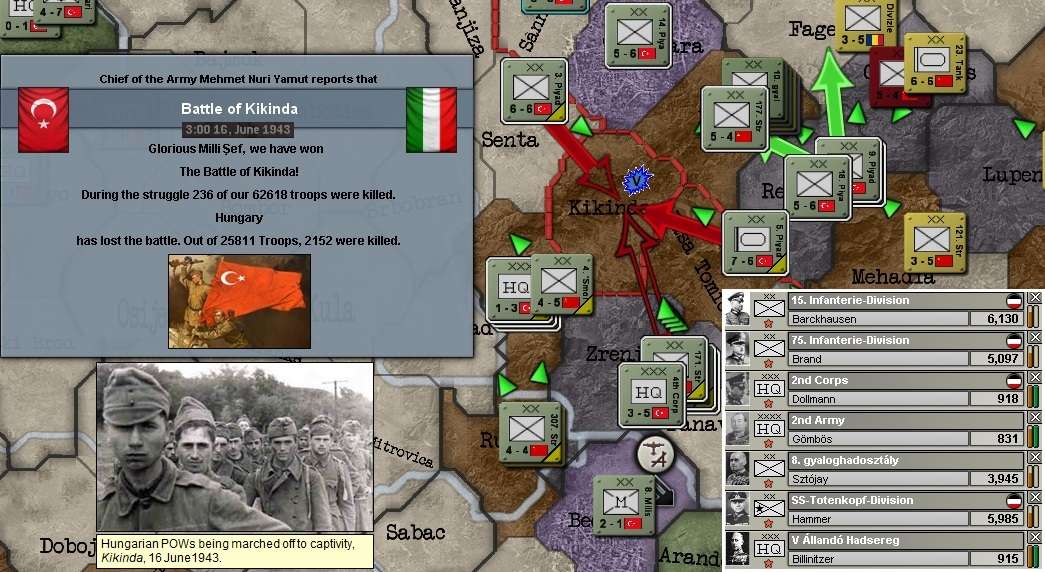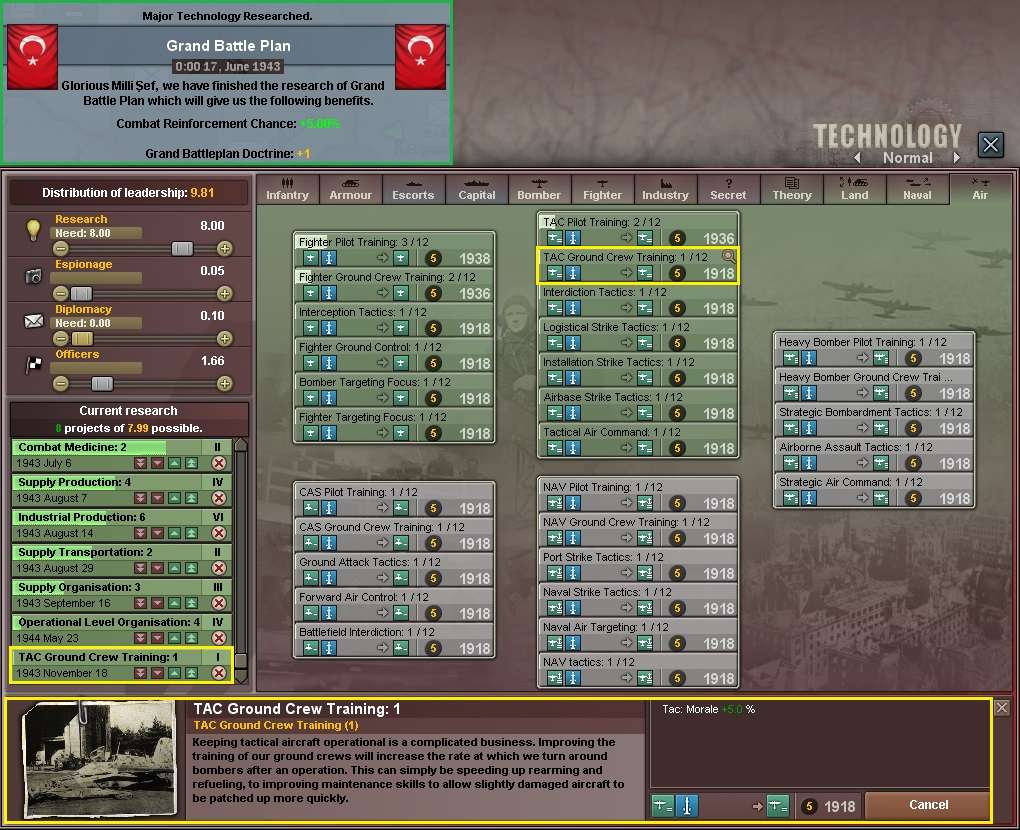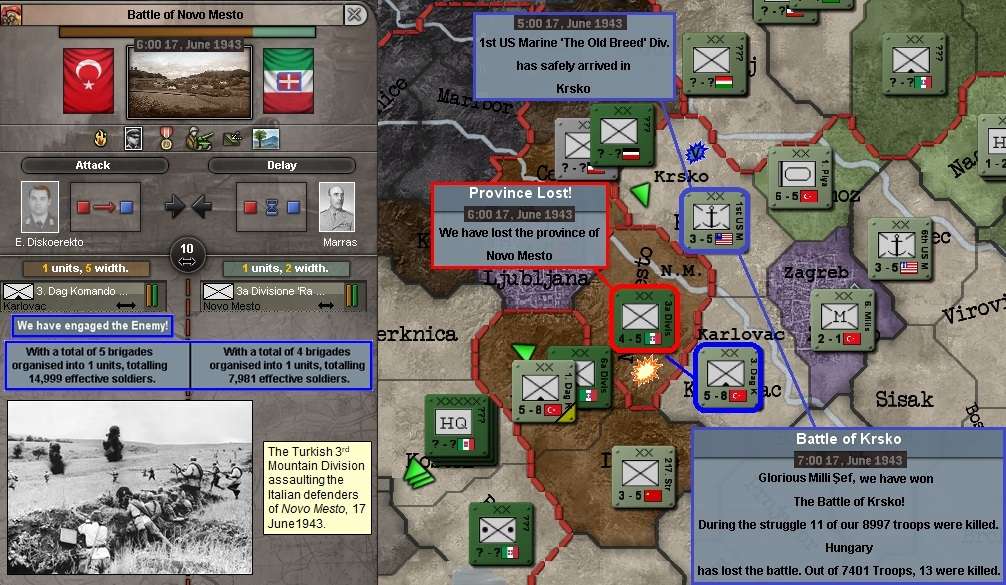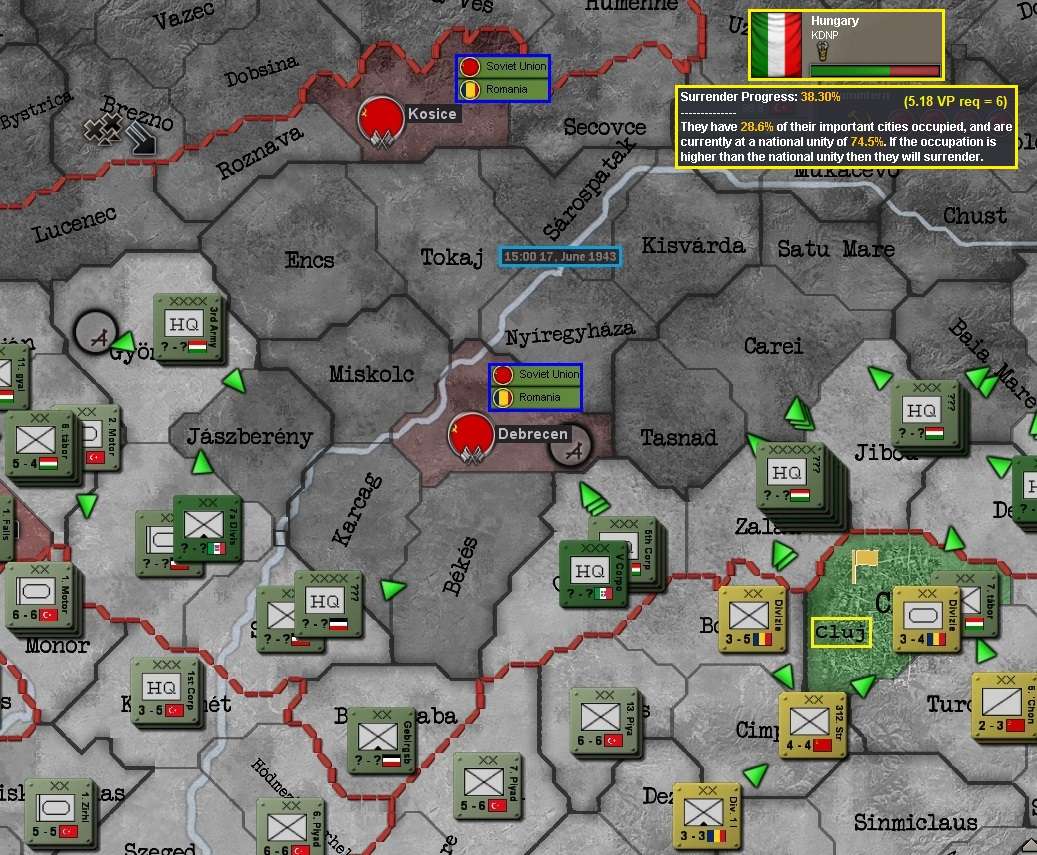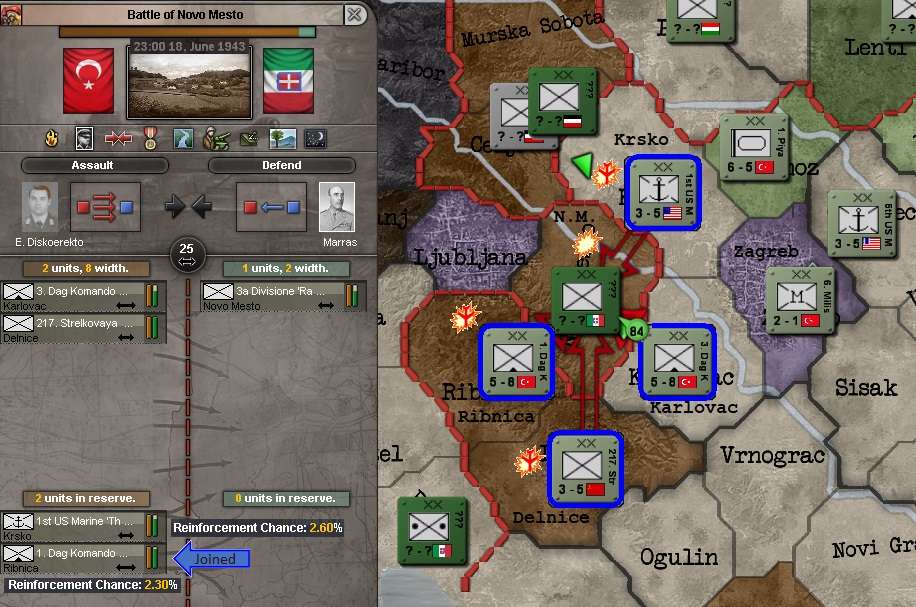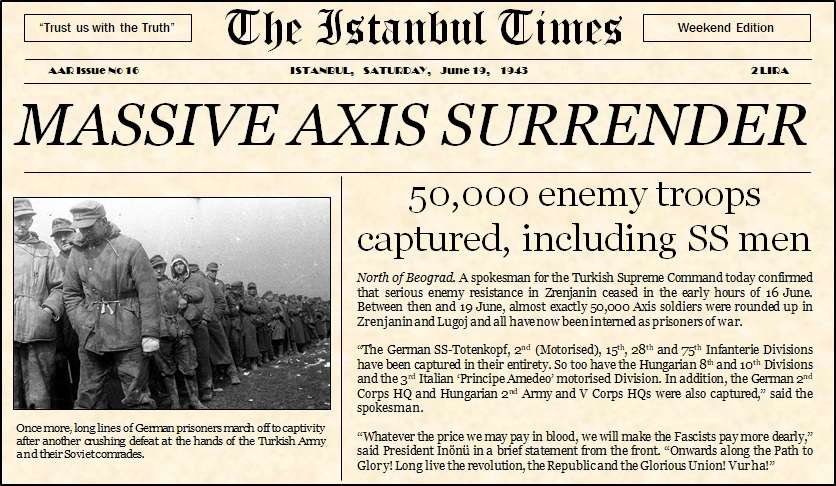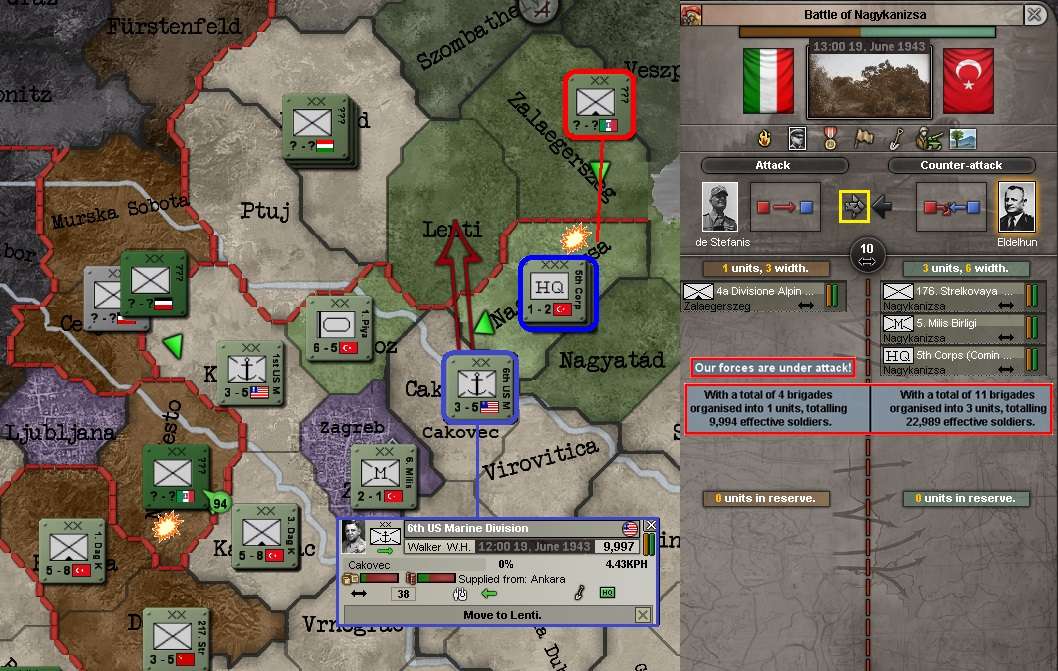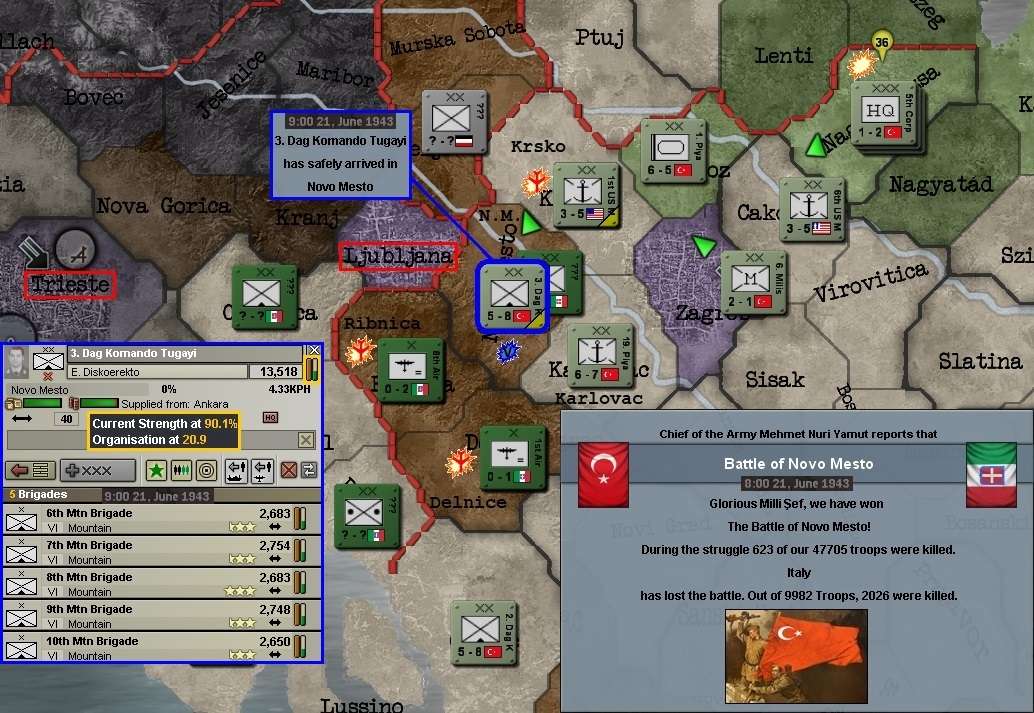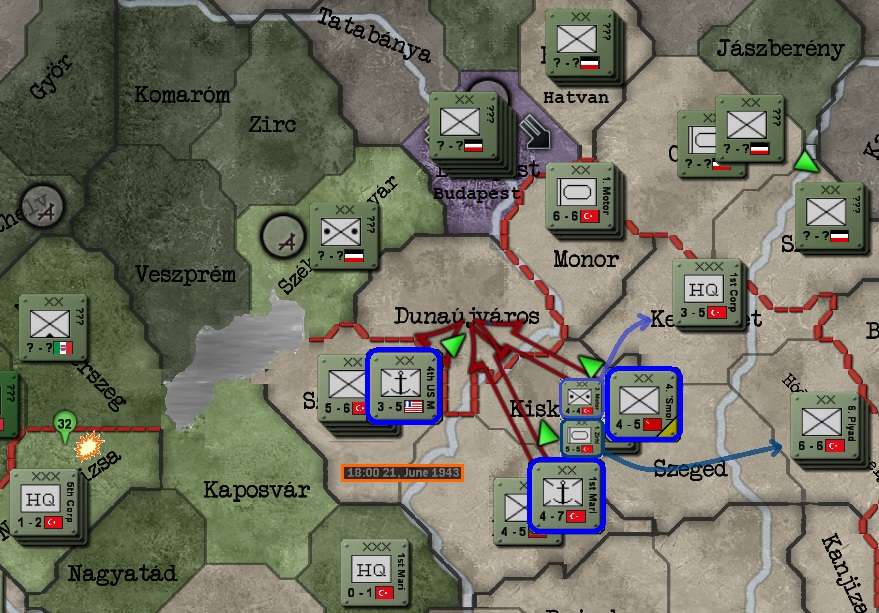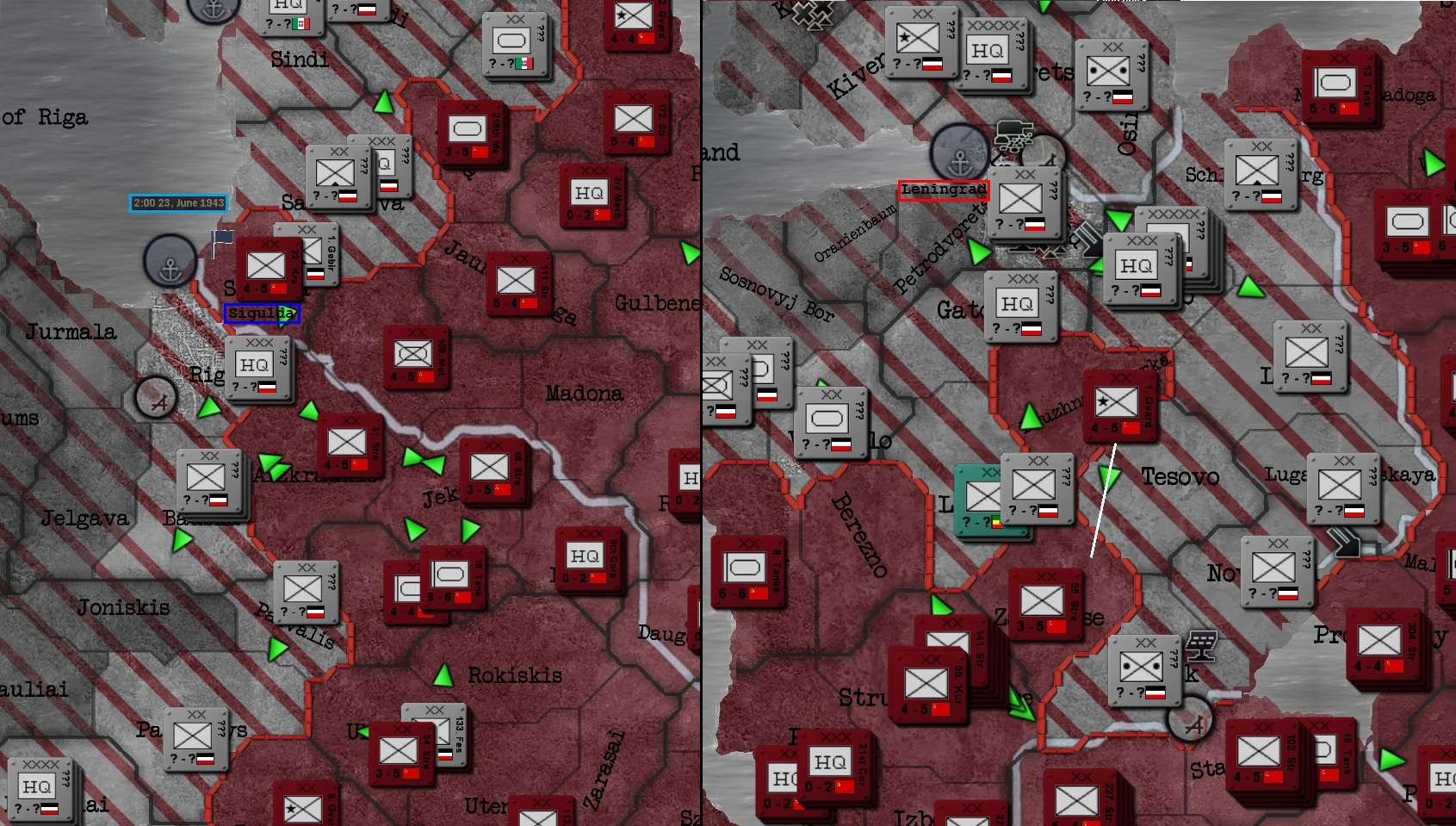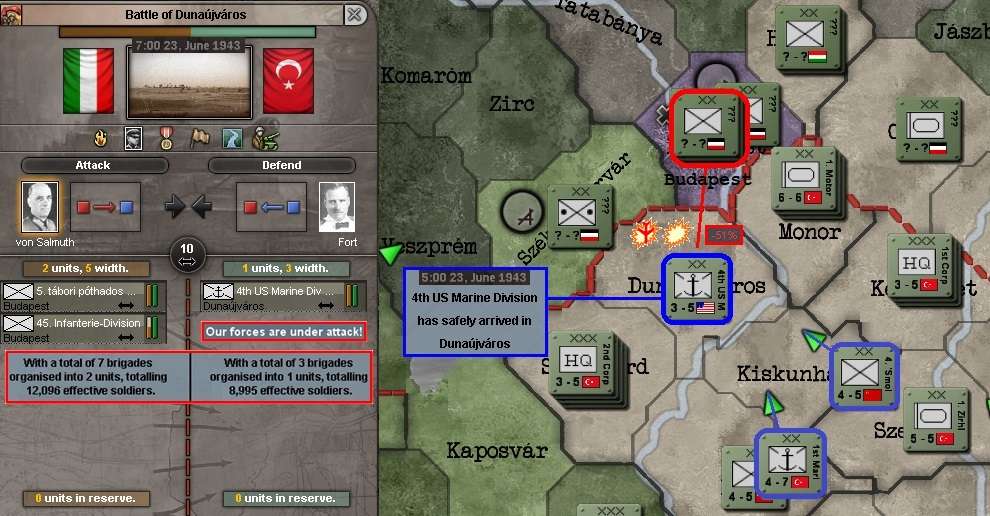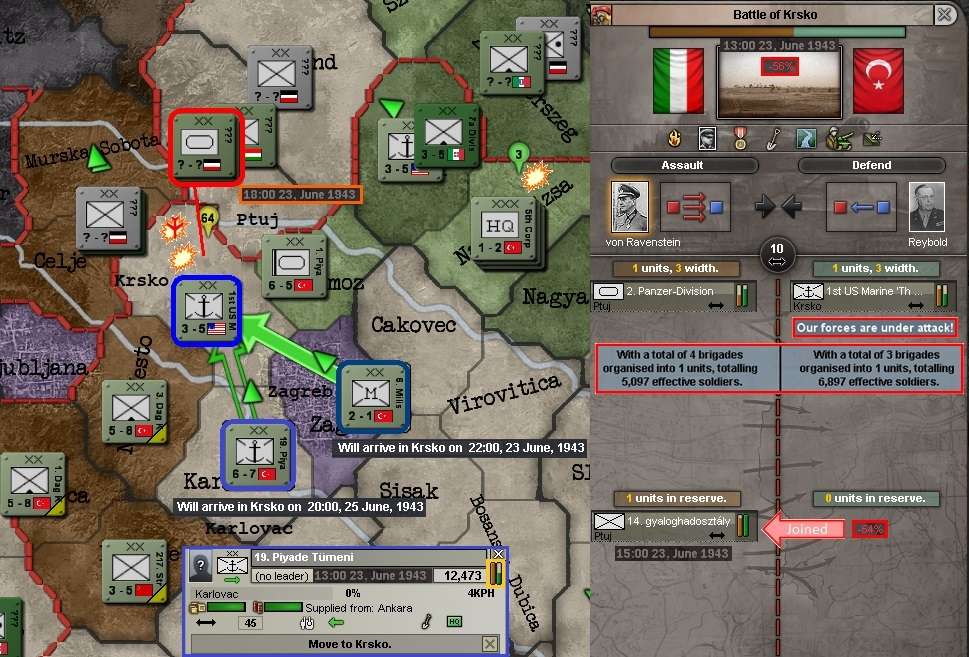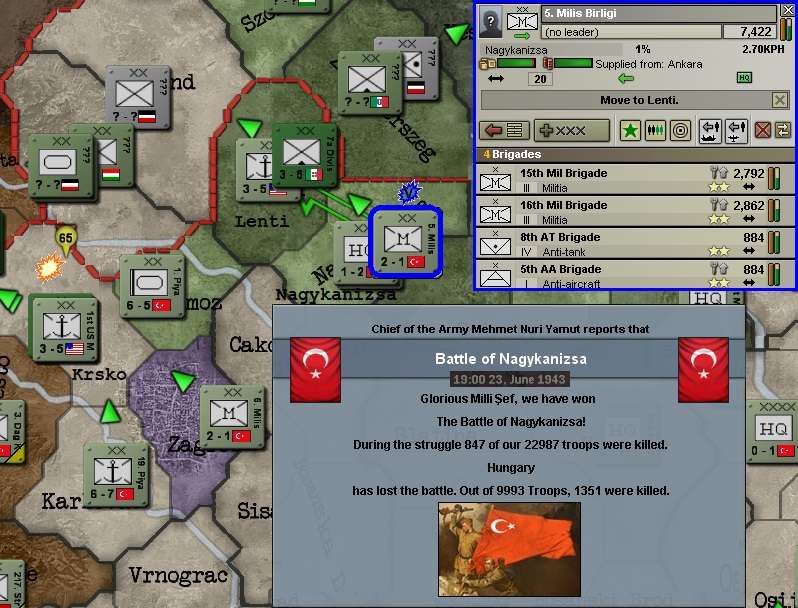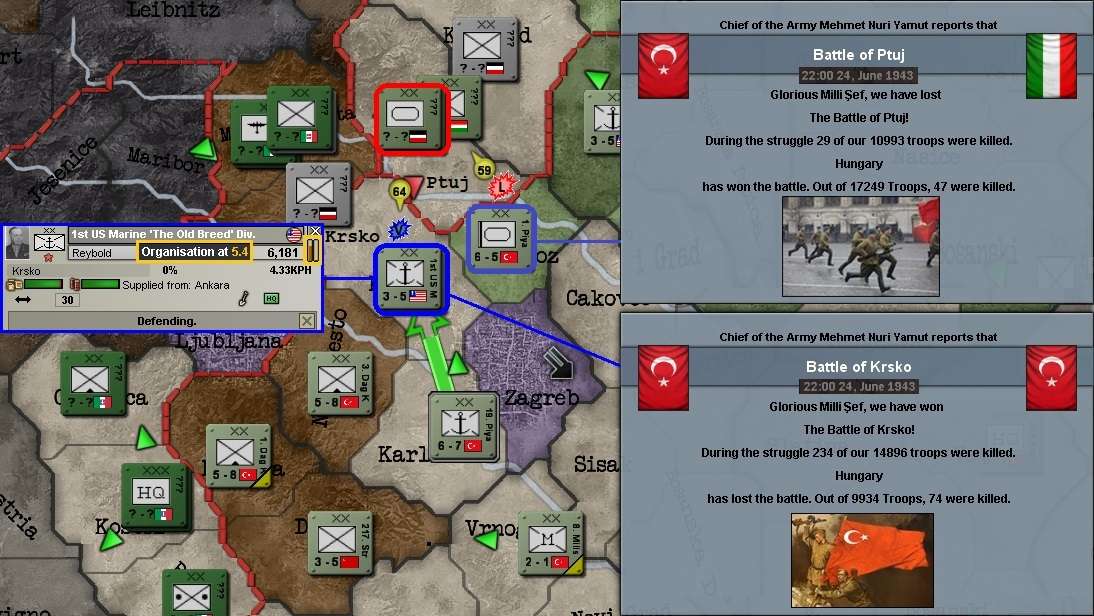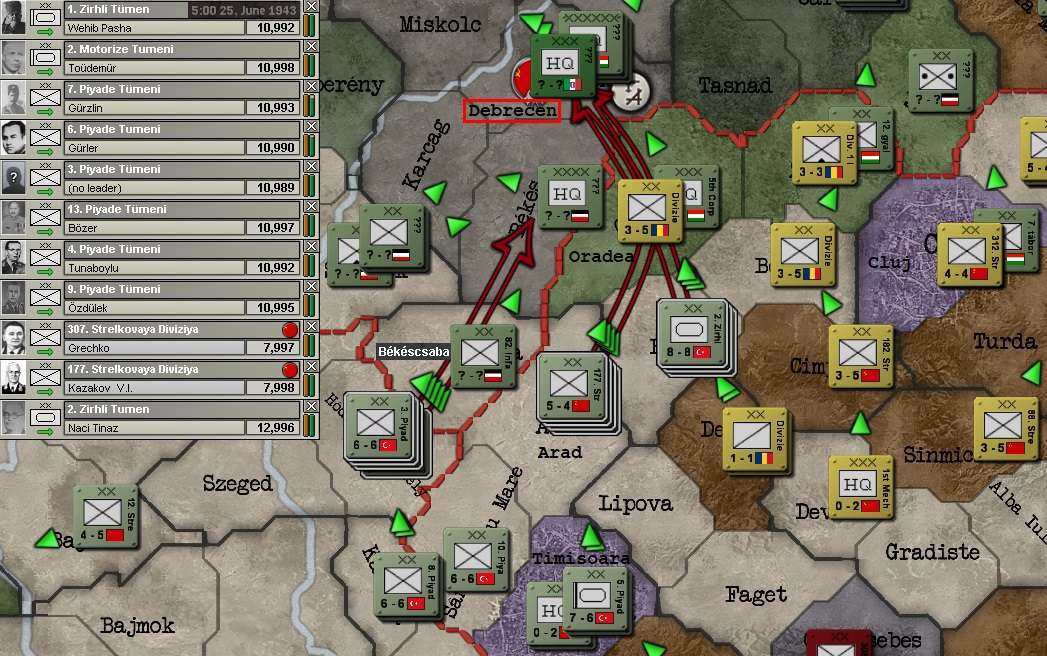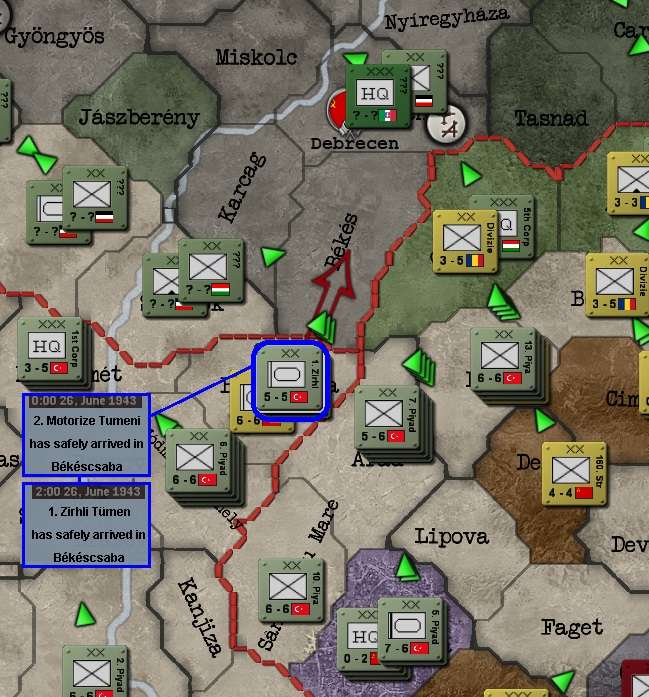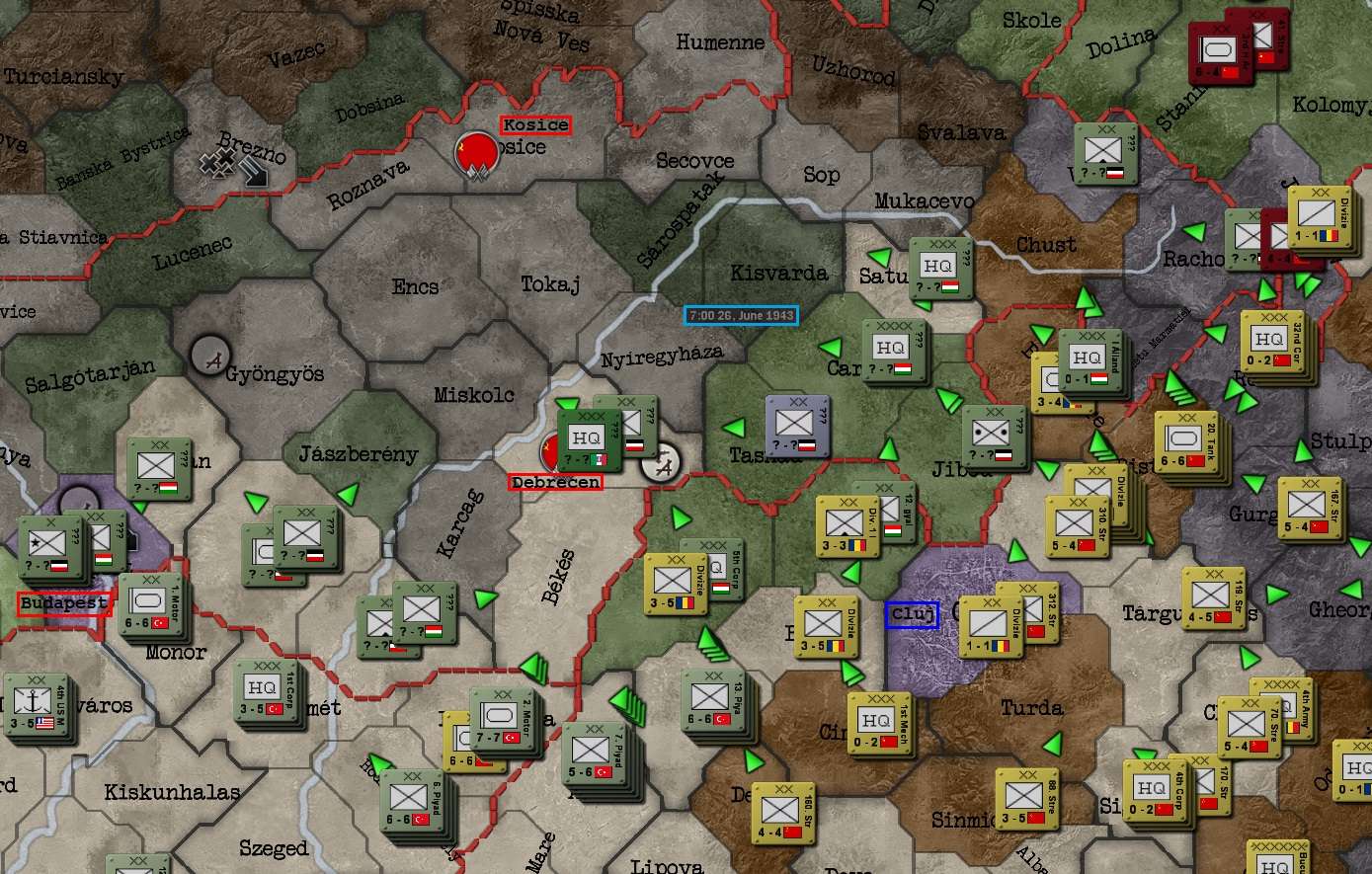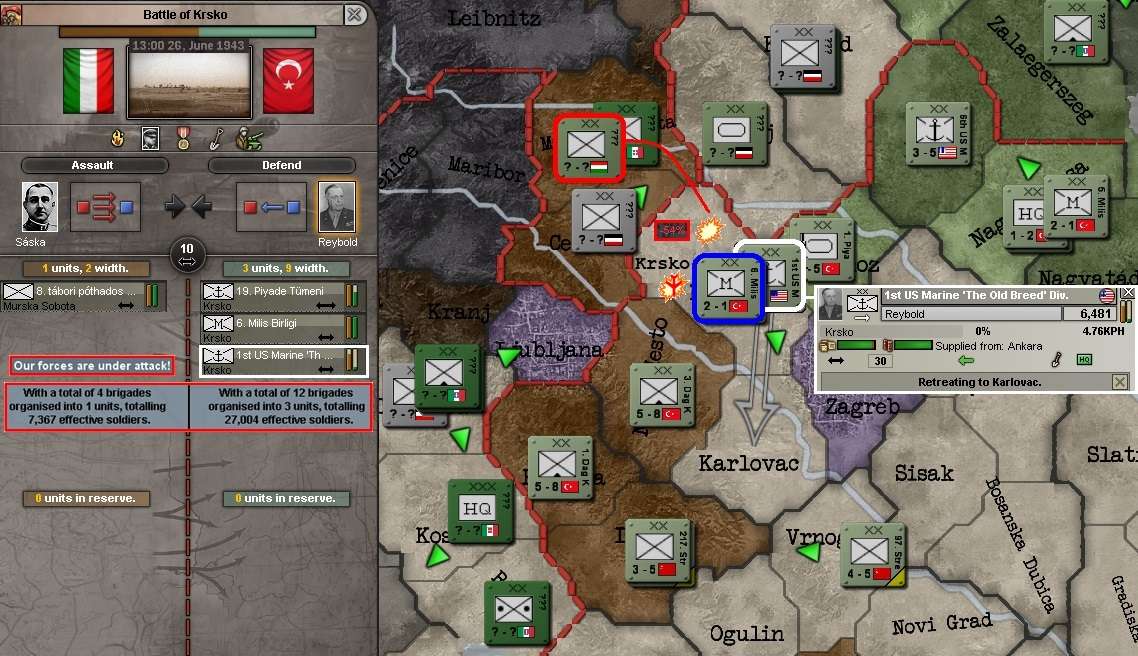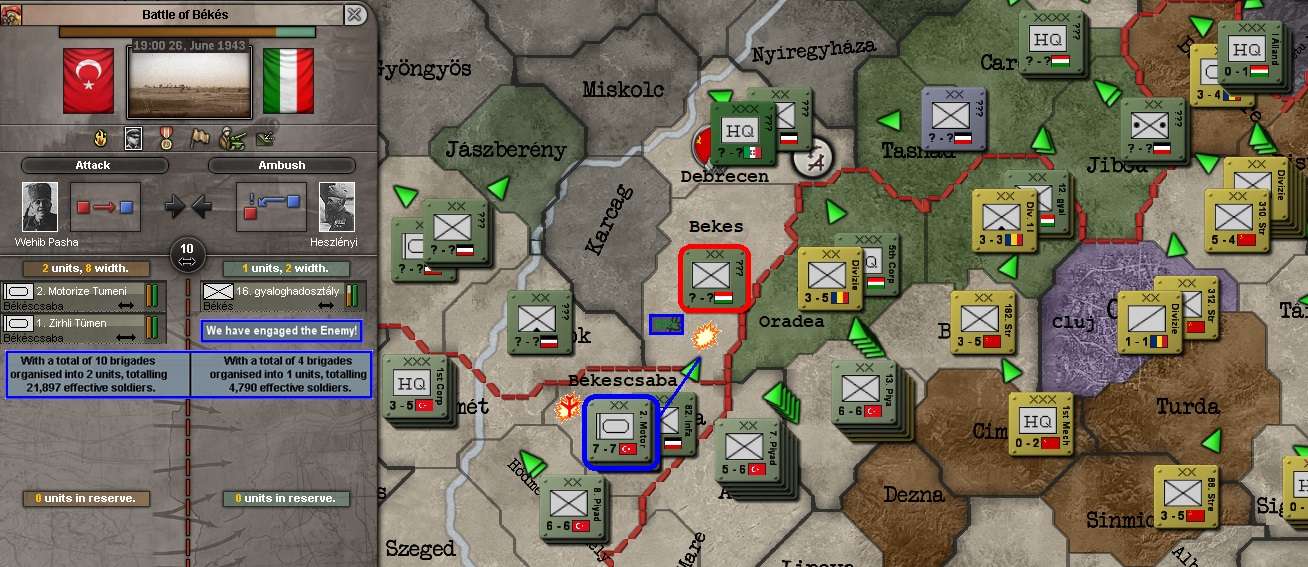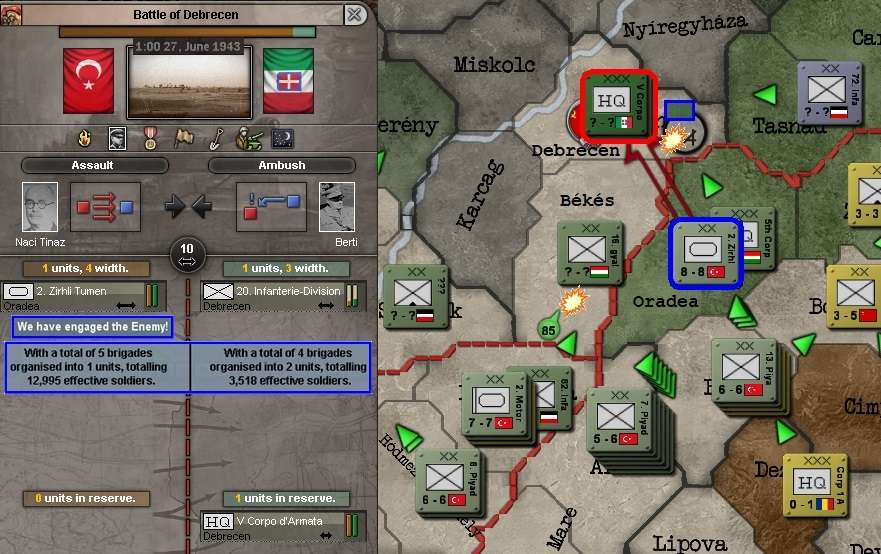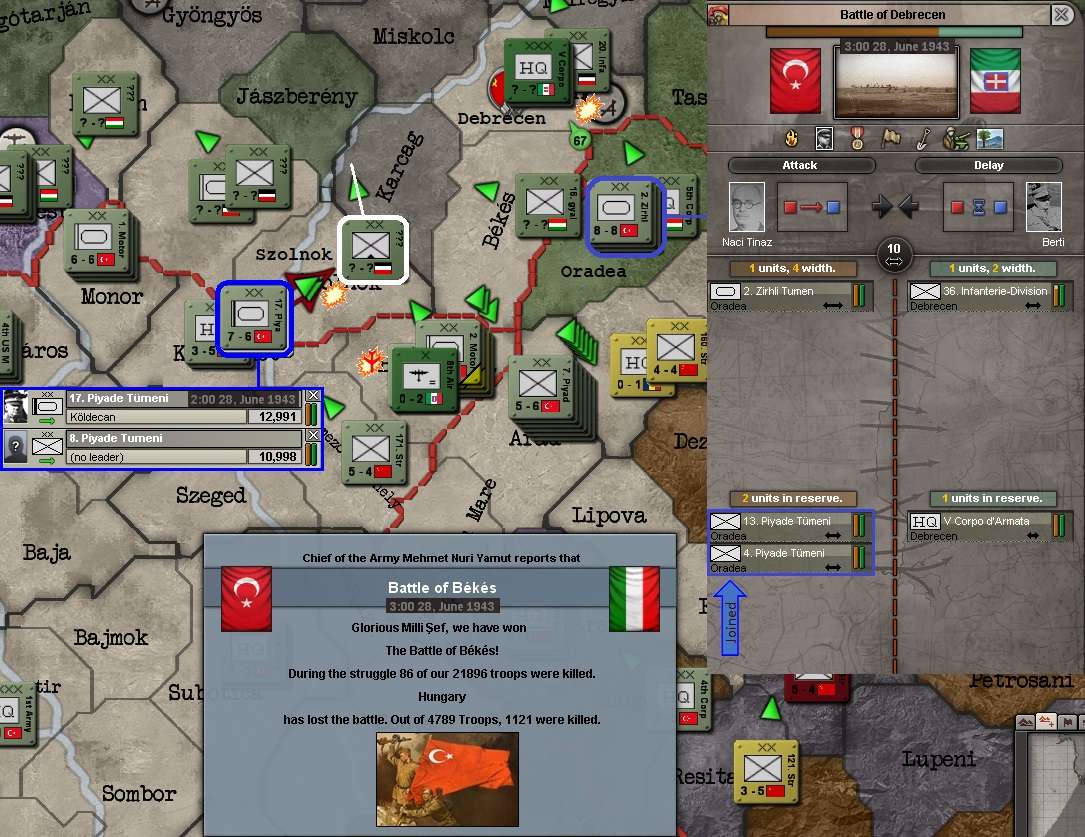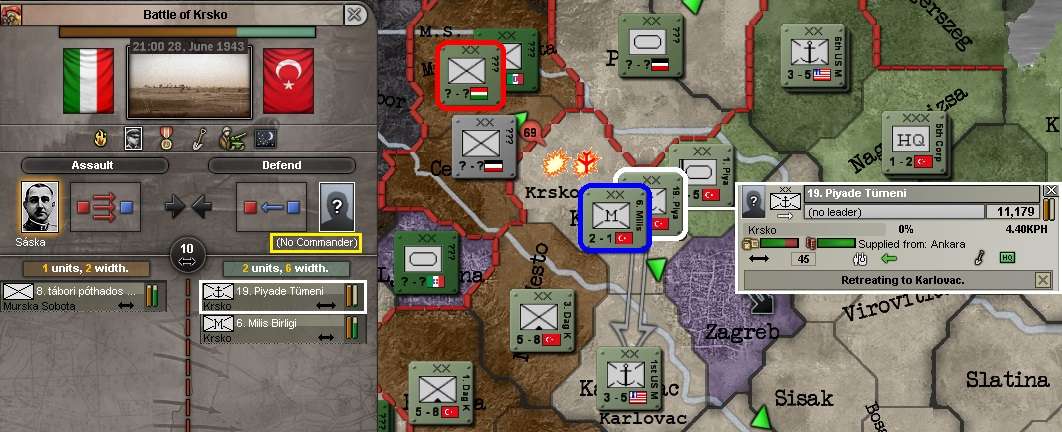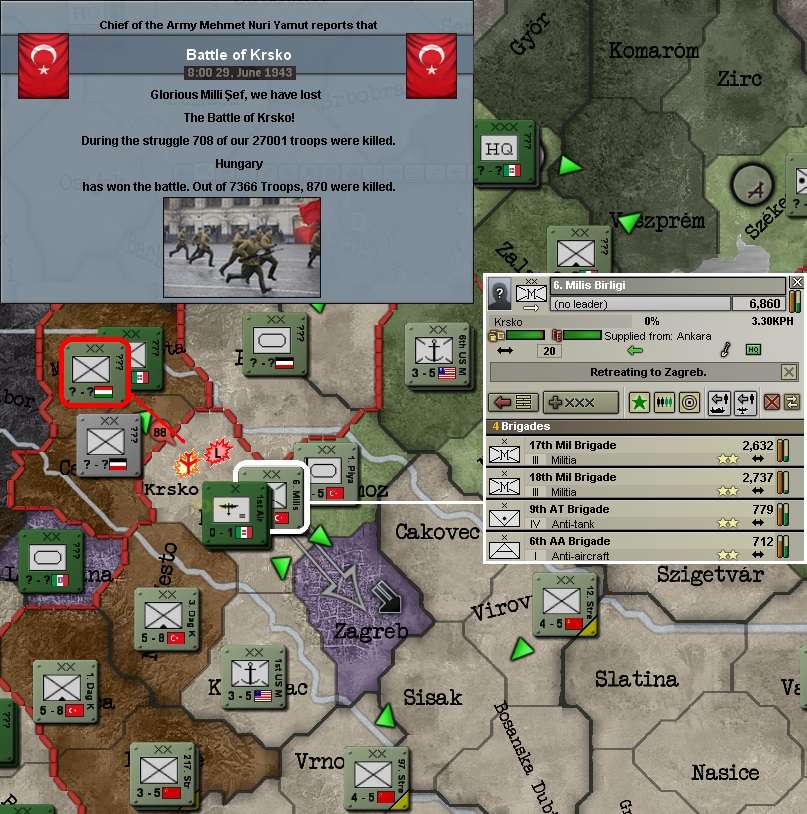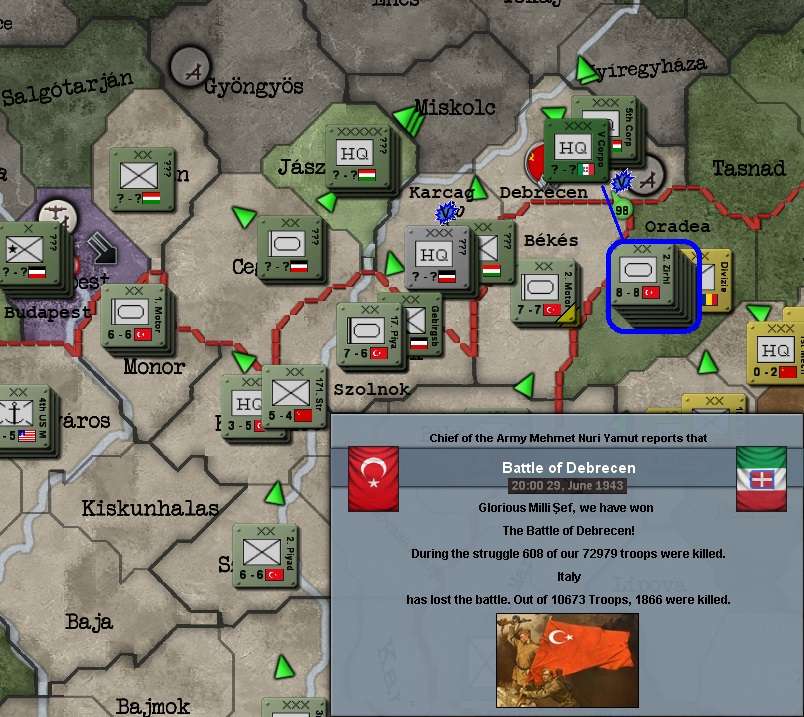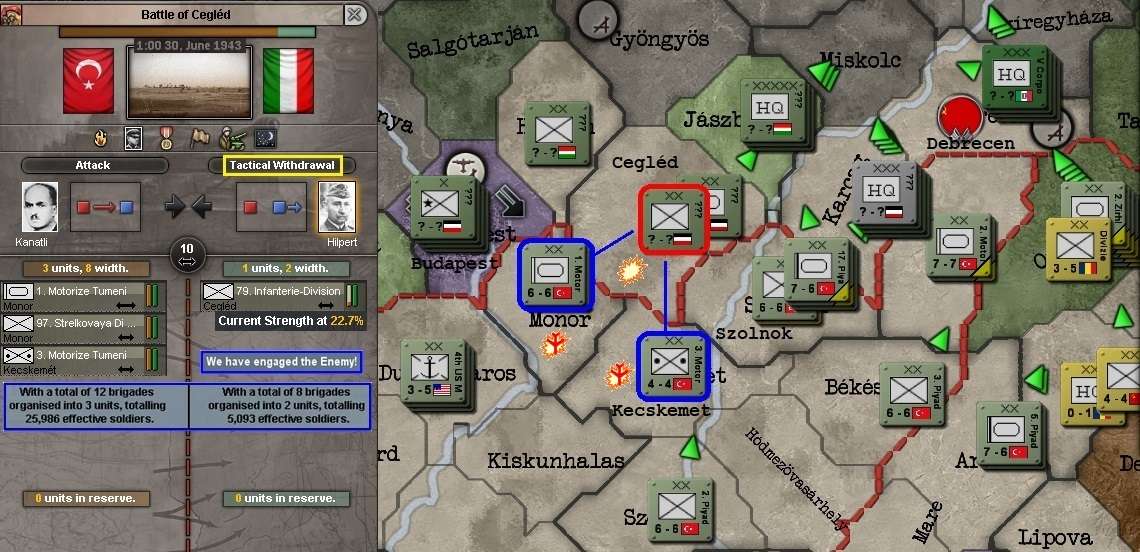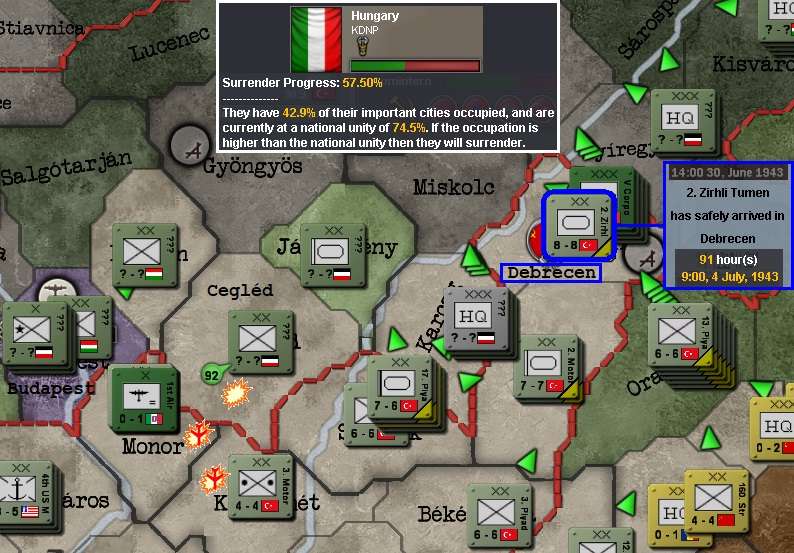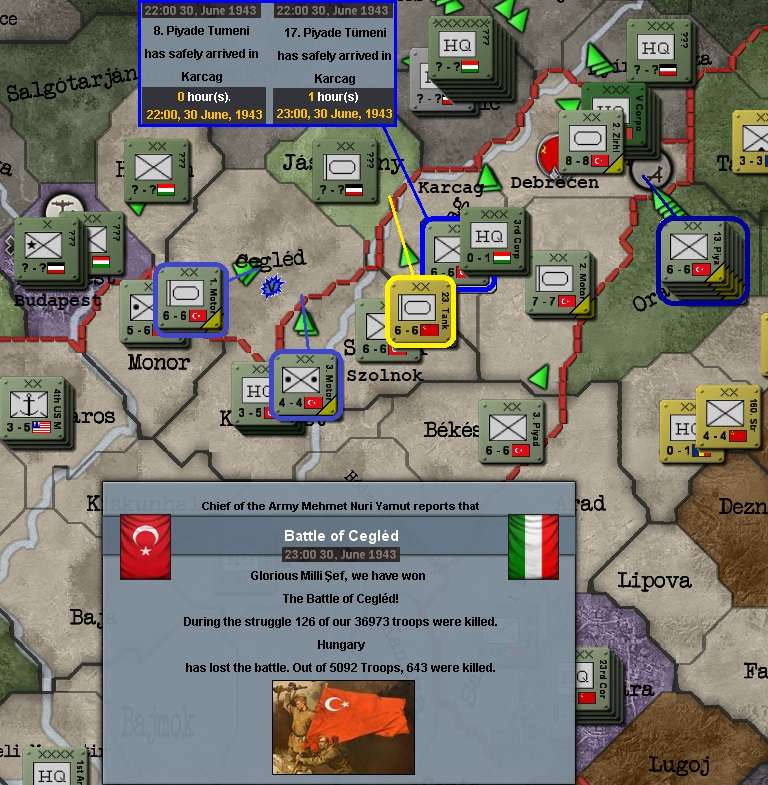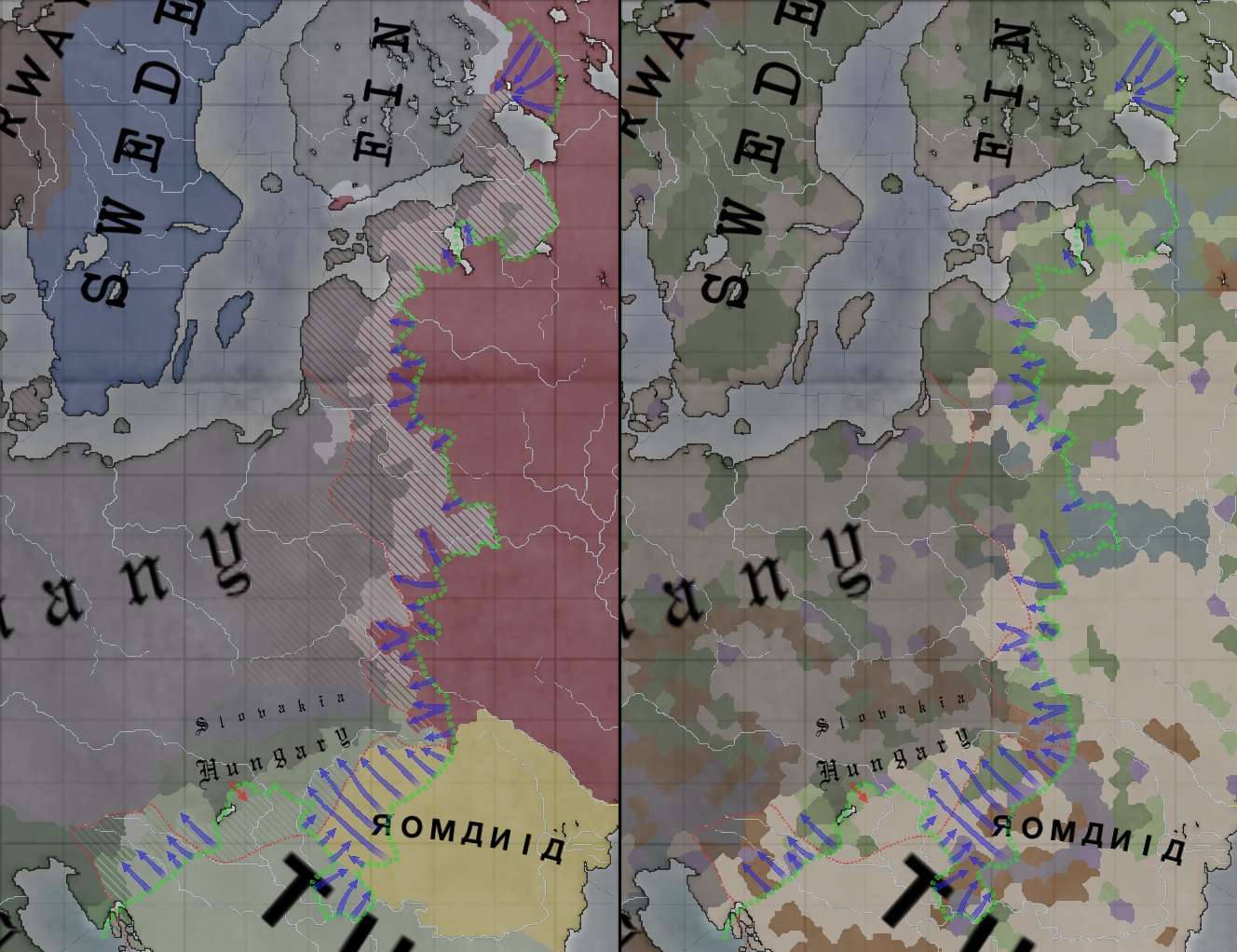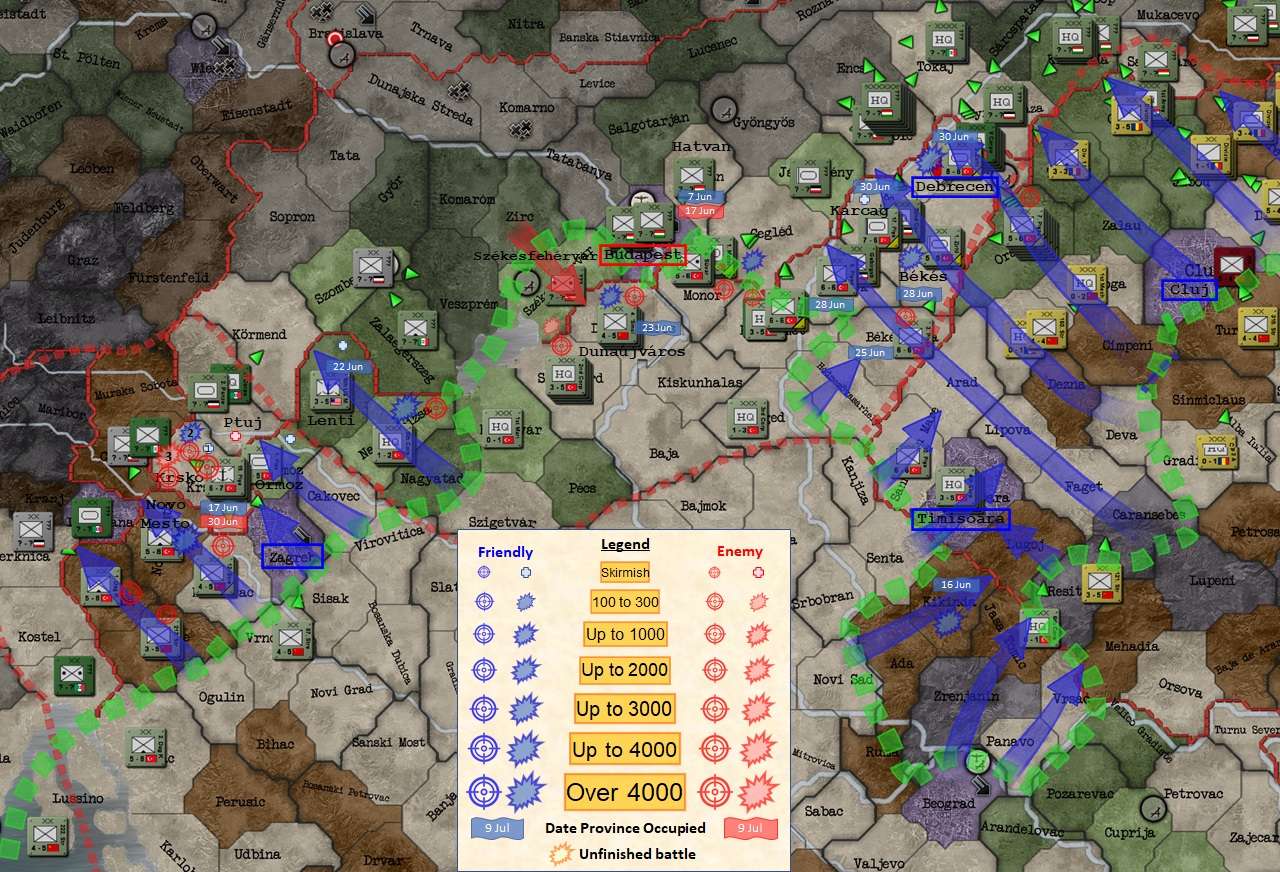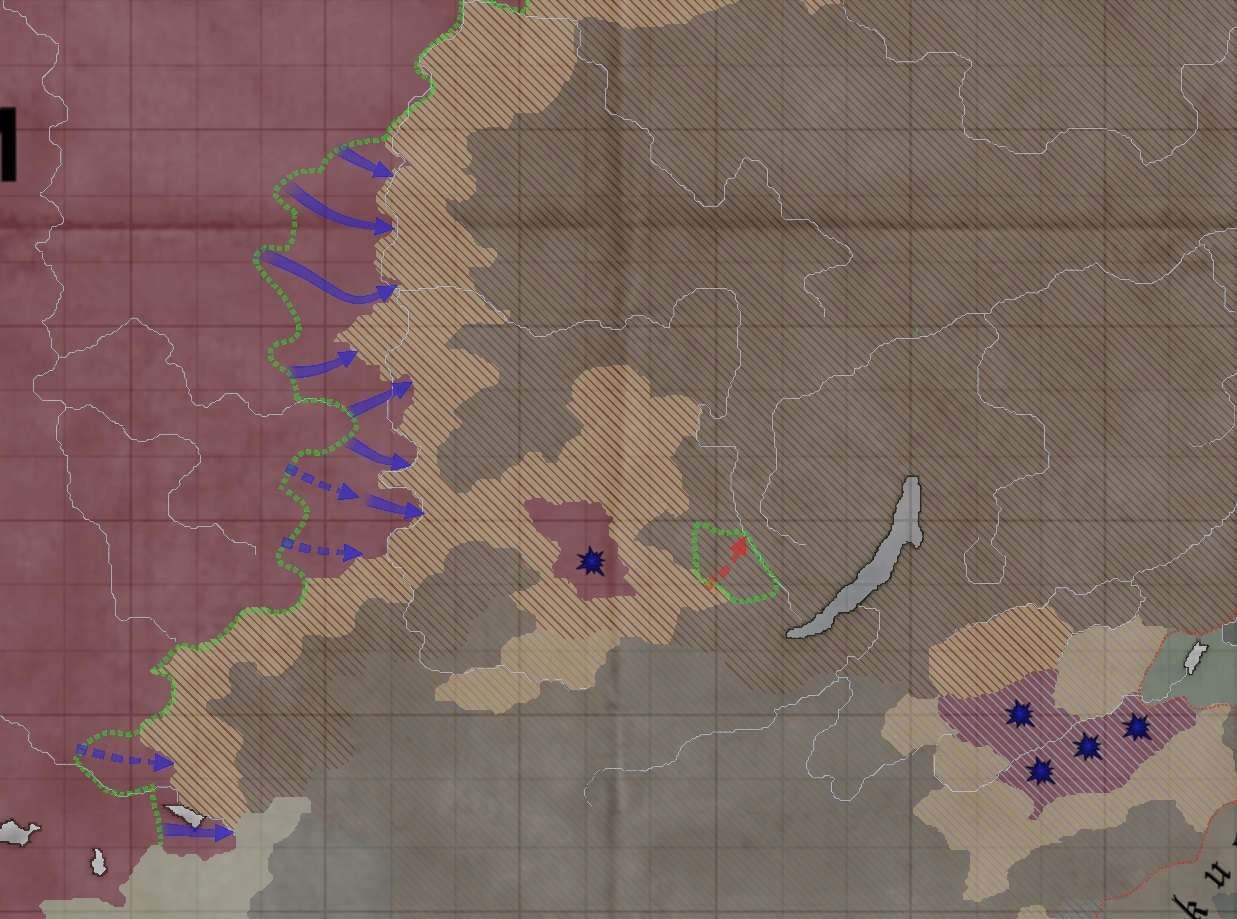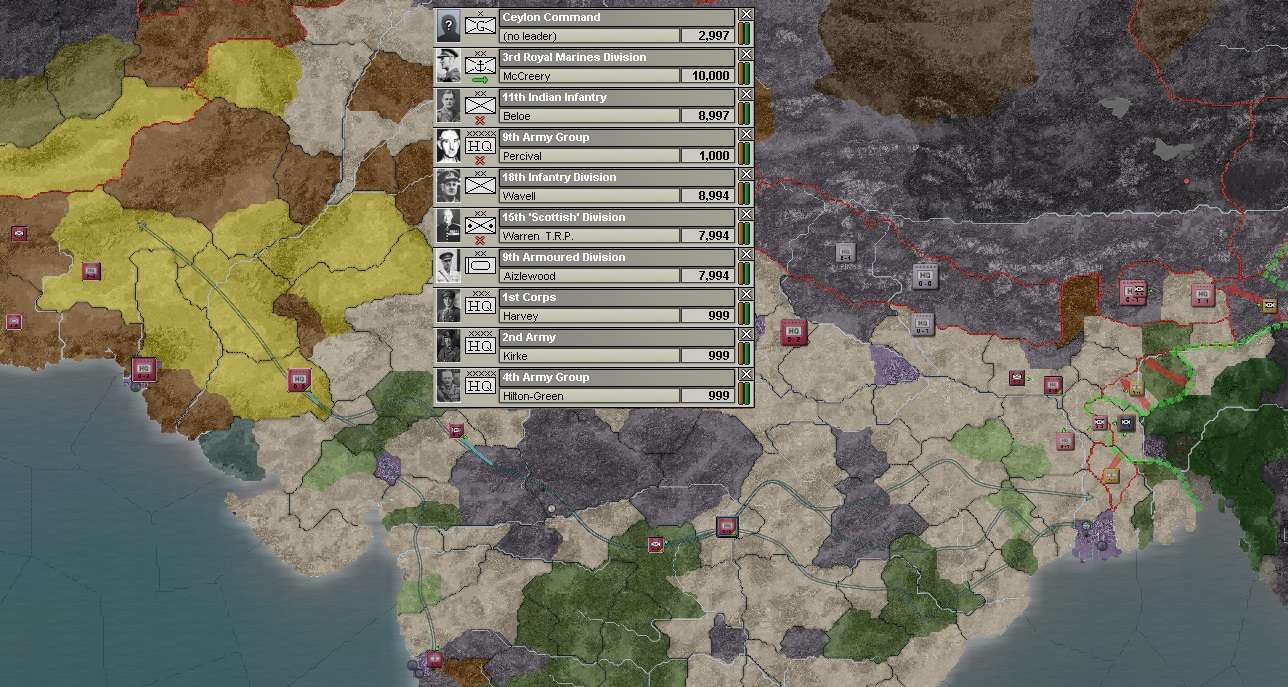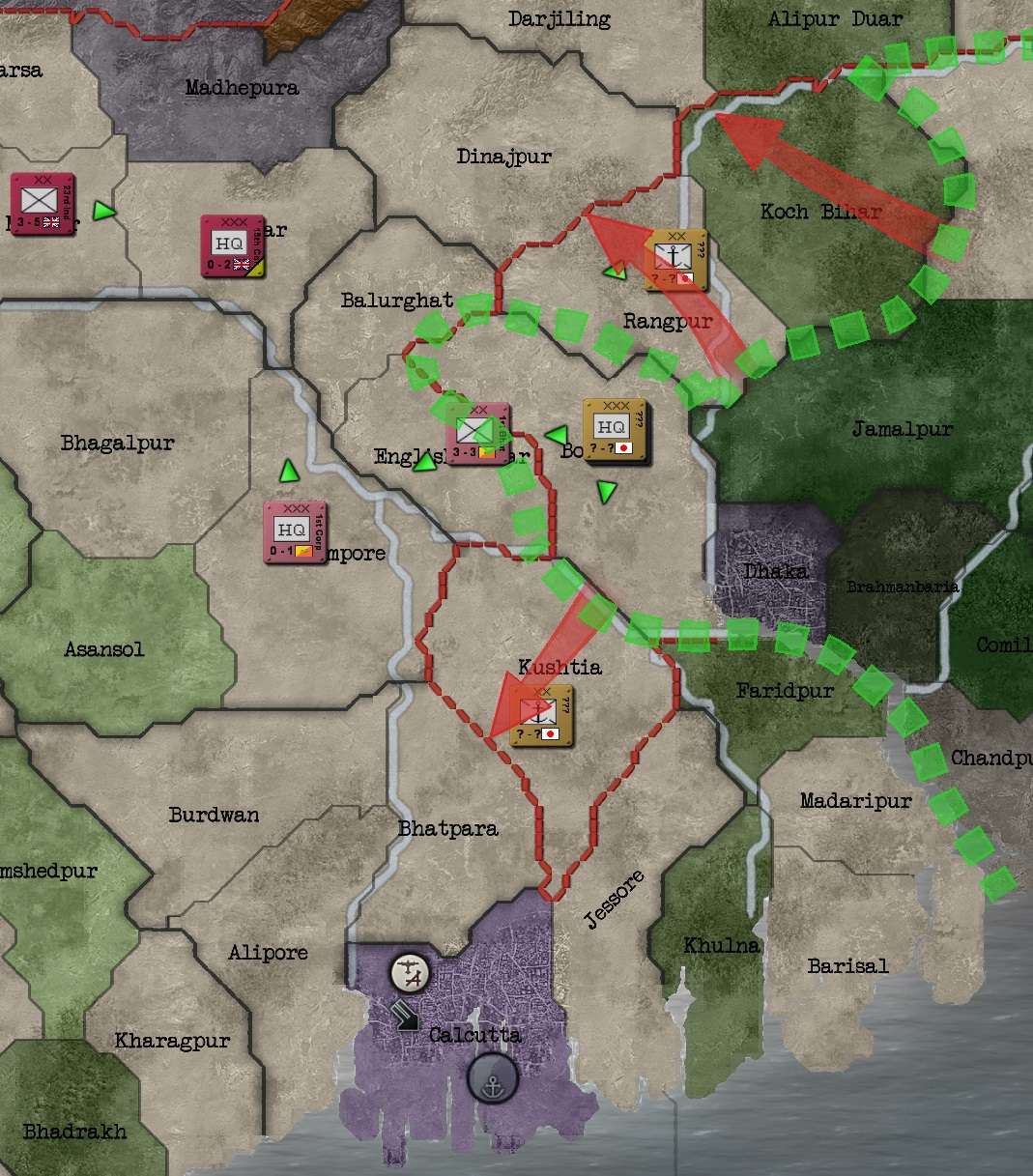Chapter 205: Death from Above (16 to 30 June 1943)
Recap
Perse, with the aid of David Callan, had foiled another assassination attempt, which revealed both that there must be more ‘moles’ within MI6 … and that whoever had been sent to attack her were not the ‘A-Team’!
At the front, the Axis was coming under increasing pressure across the whole Patriotic Front. The Zrenjanin Pocket had been closed for some days now and was on the cusp of being squeezed shut completely. The Russians and Romanians pressed forward elsewhere on the Patriotic Front, albeit all against stern Axis resistance.
---xxx---
16 Jun 43
As at midnight, two battles continued in the Turkish sector of the front. West of
Budapest, a Turkish probe on
Székesfehérvár [42%] continued, where the motorised German 4th Leichte Division had slipped in to defend the province before 156 SD could occupy it. 2 Mot Div was still retreating from
Hatvan, the attempt to surround and assault
Budapest having been abandoned for now.
The most significant ongoing battle was in
Kikinda, where the last bastion of Axis resistance in the Zrenjanin Pocket mounted by the SS Totenkopf Division was just barely holding now, under attack by Turkish forces since 14 June
[89% progress]. Tens of thousands of Axis troops – mainly German – were isolated in the pocket.
This last ditch defence in
Kikinda soon crumbled, with the latest victory declared at 3am. This brought the immediate surrender of all Axis forces then in
Kikinda. Others were still retreating there from
Lugoj, but would be rounded up over the next few days. The newspaper report would not be released for operational security reasons until the weekend edition of
The Istanbul Times, once the last prisoners had been taken.
At 9am, another minor Japanese-inspired revolt in the
Dodecanese was snuffed out, eight Turkish garrison troops killed for 100 rebels, the other 2,900 melting back into the countryside. Again.
The attack on
Székesfehérvár was called off at 2pm, with no satisfactory progress being made. The Soviet EF had lost 133 men, while the Germans suffered 83 killed.
Kikinda was secured at 6pm by 5 Inf Div, meaning there would be no further chance for the enemy retreating from
Lugoj to stage another desperate stand. It was now just a matter of taking the prisoners as they arrived.
Air Damage Report. Italian attacks on
Skekszard on 156 SD killed 493 of the Soviets who had been attacking
Székesfehérvár defenders. This was just a foretaste of the blizzard of enemy air raids that would follow over the next two weeks.
OTL News Event: Tokyo, Japan. Subhas Chandra Bose met in Tokyo with Japanese Premier Hideki Tojo, and obtained a promise that Japan would help India gain its independence from the United Kingdom. [Comment: one can imagine something similar happening in this ATL, with the Japanese still romping through eastern India.]
---xxx---
17 Jun 43
A welcome and long-awaited advance in Turkish land doctrine came on 17 June: combat reinforcement, the bane of many a battle in the past years, would be substantively improved.
Then early that morning, in the Adriatic Sector, the US Marines took
Krsko, soon beating off a quick enemy probe. But while that was happening the Italians occupied
Novo Mesto, which the Turks had earlier been forced to retreat from. MAJGEN Diskoerekto’s 3 Mtn Div was already on its way from
Karlovac and soon engaged the enemy in what would prove to be a long and savage battle.
The Hungarians reoccupied
Hatvan at 8am, while 2 Mot Div were still retreating from it south to
Monor. Then at 1pm, most of the remaining Axis divisions (two German and one Hungarian) from
Lugoj were captured as they retreated to
Kikinda, only to find it in Turkish hands. Only the Italian 3a Divisione (motorised) remained to be put into the bag.
With the pocket effectively now liquidated, the Romanians had retaken
Cluj and continued to advance strongly in their sector. New objectives were suggested to the Soviets and Romanians: the key Hungarian cities of
Debrecen and
Kosice (both of which had been occupied by the Comintern early in the war, while France still fought on).
Note: at their current national unity, these two VP cities plus Pécs (already occupied), would still not be quite enough to force a Hungarian surrender – Budapest would still probably need to be taken.
Up in the Baltic Sector, the Germans had once again retaken
Sigulda, the coastal province that maintained land communications with the almost-encircled Army Group North: but yet another Soviet counter-attack was already in progress.
Air Damage Report. The Italians began heavy aerial attacks on
Karlovac on 3 Mtn Div in
Karlovac, which would continue into the next day. They also struck
Krsko, which would continue without let up for another five harrowing days.
---xxx---
18 Jun 43
The reason for the continuation of intense air strikes on
Krsko was presumably because at 3am 1 US Mar Div joined the attack on
Novo Mesto in support of 3 Mtn Div
[2.6% reinforcement chance].
Further east, 2 Mot Div (still in very good condition) had finished its retreat from
Hatvan to
Monor at 8am and was sent straight on to the south-east, to join the forces gathering north of
Timisoara for a renewed offensive following the elimination of the Zrenjanin Pocket. This fast and powerful outfit should be useful if they got loose on the Hungarian plain. The first formations redeployed from the pocket were already arriving on the front line by then.
217 SD in
Delnice was added to the attack on
Novo Mesto at 9am and reinforced almost immediately, improving the odds further
[82% progress]. Then late that night, 1 Mtn Div in
Ribnica added its weight to the attack on
Novo Mesto, where 3 Mtn Div was finding the attack tough.
Air Damage Report. Enemy air raids finished on
Karlovac that night, having caused 1,392 casualties since the day before, while the effort stayed on
Krsko and now also hit both
Ribnica and
Delnice simultaneously from late on 18 June in a massive effort to try to disrupt the attack on
Novo Mesto. All these raids would persist non-stop through 21 June.
---xxx---
19 Jun 43
The last Italian division surrendered at 8am as it limped into
Kikinda. The whole pocket was now completely shut down.
6 US Mar Div began advancing on the empty
Lenti at midday, while an hour later Italian mountain troops struck
Nagykanizsa in a strong attack, but it was hampered by a very effective counter-attack by the 5th Corps commander, LTGEN Edelhun. Still the battle for
Novo Mesto ground on to the west of
Zagreb, under heavy enemy air attack.
For the first time since June 1940,
Beograd was so removed from any direct threat that its last garrison troops (a division of the reinforced militia) was put on trains at 3pm and sent to reinforce the line west of
Zagreb.
1 Mtn Div reinforced the attack on
Novo Mesto at 10pm
[95%], but still the Italians refused to give up. Both they and 3 Mtn Div were becoming fairly worn down by this stage.
Air Damage Report. Another day of enemy raids
Krsko,
Ribnica and
Delnice took their toll on the forces attacking
Novo Mesto.
---xxx---
20 Jun 43
While Turkey now had three divisions in the front line and one in reserve attacking
Novo Mesto, the German 93rd Infanterie (low on strength but high on organisation) joined and then reinforced the Italians between 6am and 8am. Just as the latter were weakening (they would retreat at 4pm that same afternoon): the fight would now drag on further, into the following day.
At this point, Inönü began to start tracking reserve manpower more closely: the ground combat but particularly the incessant air raids were wearing it down more quickly now. At the start of 16 June it had stood at 41,000: by 10am on 20 June it had dropped to 36,000 with 3,210 reinforcements needed to reinforce.
Air Damage Report. The enemy air raids
Krsko,
Ribnica and
Delnice continued.
---xxx---
Interlude: London – ‘The Hour Before Dawn’
Following here escape a few days before, Perse had been laying low in a nondescript ‘off the books’ apartment provided David Callan.
“I’m sure MI6 in London itself has been infiltrated by the Comintern,” Callan had insisted. “It was not just MacLean. Probably the Soviets, or possibly the S.I.T.H., have someone working there. Those thugs sent to do the dirty work the other night were Romanian, so it has been deduced.”
“Acting on behalf of …?” asked Perse, thinking it may be her old employers back in Turkey.
“Hard to tell. In a way, it doesn’t really matter. London and I suspect England is just too hot for you at the moment, Perse. I have a RAF contact who can smuggle you out on a flight to Washington, if you’re game. Once there, you can make contact with your American friends – but not before. If it gets out here in advance that you’re heading over, well …”
“Enough said, I’ll take my chances with BJ’s crowd. They may be in the Comintern formally, but their affection is more superficial and it was they who saved me, after all.”
“Right then, Perse. I’ll send my man over later this evening. A Group Captain Nigel Featherstonehaugh
[pronounced 'Fanshaw']. Here’s a picture of him and he'll have a password I'll give you now. Be careful, but I’m sure he can be trusted.”
Later that night, Callan was gone when Hawthorn knocked on the door. Perse allowed him in after he provided the password Callan had provided, but she was still wary.
“Are you
absolutely sure you weren’t followed, dear boy?”
“Quite, my dear. No flies on me!”
“Are you absolutely sure you weren’t followed, dear boy?”
“Very well, come on in. Here’s a little bite to eat while we discuss plans.”
“Charming. Now, there is a ‘milk run’ flight leaving an hour before dawn tomorrow. Despatches and such. Heading to Washington via Reykjavik. I’m commanding it. I will cover your passage as a diplomatic mission – David has provided me with some papers. You may be recognised after the fact, but by then you will be in the States. The crew themselves can be trusted during the flight and won’t know you’re coming beforehand. Dress plainly and warmly. I’ll have a staff car pick you up at 3am. Any questions?”
“Now, there is a ‘milk run’ flight leaving an hour before dawn tomorrow. Heading to Washington via Reykjavik.”
There were none. Soon, Hawthorn had left and Perse was making her preparations.
---xxx---
21 Jun 43
At midnight, 1 US Mar Div became the fourth Comintern division to reinforce at
Novo Mesto [96% progress]; the Germans fought on, though they were now becoming disorganised. The enemy attack on
Nagykanizsa also continued.
Three hours later, with USMC LO MAJ Kenny ‘Wraith’ Loggins passing on mounting concerns about a possible enemy counter-attack on
Krsko with 1 US mar Div committed in
Novo Mesto, 6 Mil Div was ordered to march up from
Zagreb to reinforce the position in
Krsko. In line with these concerns and with the battle nearly won in
Novo Mesto, 1 US Mar Div was peeled off the attack at 4am even though they had only recently reinforced. They were still under heavy air attack and needed time to recover some organisation and to dig in. Furthermore, the Turkish command didn’t want them being drawn into
Novo Mesto when the battle was won, leaving
Krsko open.
Meanwhile, Perse managed to slip aboard her flight to hoped-for safety while the airfield outside London was still dark. The crew, while a little surprised to see her, were happy to have such an attractive passenger on board. A few thought they recognised her from previous press reporting. The rest of the flight would prove uneventful.
At 8am the battle for
Novo Mesto was finally won and 3 Mtn Div occupied it just an hour later. The Italians had suffered heavy casualties in the ground combat, but the real toll for the Comintern forces had come from the skies. The raids would only stop that night, but the cost was great.
Air Damage Report. The enemy air raids on
Krsko (17-21 June) killed 2,595 US marines, in
Ribnica (19-21 June) it was 1,469 troops from 1 Mtn Div and in
Delnice (19-21 June) another 894. In other words, almost 5,000 men, on top of the 1,400 in the earlier raids on
Karlovac and over 600 killed in the ground combat. This had been a very bloody affair.
6 US Mar Div fought and won a brief skirmish in
Lenti against some Italian troops passing through (12 v 18 casualties) at 2pm and kept advancing. Then at 6pm, reports came that
Dunaújváros had been vacated by the enemy, so three of the divisions that had been assembled to defend the possible breakthrough instead advanced to reoccupy it, while others (the armoured formations) were sent to prepare for the next offensive into central Hungary.
22 Jun 43
With the cessation of the enemy raids connected with the battle for
Novo Mesto, at 2am their attention was drawn to
Nagykanizsa, where the Italians were still attacking
[-29%]. With that battle continuing throughout the day,
Lenti was occupied by 6 US Mar Div at 6pm. The air raids also extended into the following day.
---xxx---
23 Jun 43
Early that morning, Agent SkitalecS3 delivered the latest update from the northern front. The Soviets were once again holding
Sigulda, though the foothold remained precarious. They had also made a push up towards
Leningrad, led by the 1st Guards Division, but it seemed this brave foray had recently been turned back. And, as a curiosity, it seemed some Ethiopian units were fighting in that sector! They wouldn’t enjoy the winter very much if they were still there by year’s end!
4 US Mar Div (which didn’t have to cross a river) was the first back into
Dunaújváros early that morning, but were soon being attacked from
Budapest. At least the ‘mobius strip’ river that 'encircles' the city while running through it means any attack
from it is also a river crossing. The marines will certainly need the help that is still on its way from the south. And of course, the drone of enemy bombers soon heralded another aerial pummelling for the defenders and the Turkish Air Force was still not sufficiently recovered to believe it could make a meaningful intervention at this point and none of the tactical situations were so dire that a desperate play seemed necessary.
Then the previous suspicions of an attack on
Krsko were turned into reality early that afternoon, with 2 Pz Div launching an attack from
Ptuj, just before 6 Mil Div was able to arrive. The partly-recovered 19 Inf Div was also ordered up from
Karlovac as
Krsko once again came under air attack. Two hours later, a Hungarian division joined the attack, though was yet to reinforce.
But a little to the east, the Italian attack on
Nagykanizsa came to an end that evening with a hard-fought Comintern victory. This prompted orders for 5 Mil Div to start pushing forward to reinforce 6 US Mar Div in
Lenti.
6 Mil Div duly arrived in
Krsko at 11pm, but would now need to reinforce
[2% chance, odds back down to -53%].
Air Damage Report. The enemy air raids on
Nagykanizsa ended, with 1,180 Comintern troops killed over the two days. Raids supporting the enemy attacks on
Dunaújváros and
Krsko (which started that night) would carry over into 24 June.
---xxx---
24 Jun 43
4 SD arrived in
Dunaújváros at 6am and, even though they did reinforce straight away, it seems their arrival
[sending enemy progress to -15%] was enough to cause an end to the attack at 8am. The Axis lost 204 men, while the defending US Marines had lost 228. With the province now secure, another of the ‘second line’ formations (the recovering 12 SD just to the south in
Baja) was also sent west to reinforce the Adriatic Sector at 10am.
This was in part prompted by the fact 1 US Mar Div was failing in
Krsko by 6pm and would not be able to hold on for much longer alone, with 6 Mil Div in place but still waiting to reinforce. To try to rescue the situation, Orbay’s IS-1 veteran equipped 1 Inf Div launched a spoiling attack on
Ptuj from
Ormoz, hitting the attackers in the flank at 7pm.
Five hours later, the ploy succeeded – and not a moment too soon.
Krsko was saved for now, with 19 Inf Div also soon to arrive to beef up the defences. The short but successful spoiler on
Ptuj was called off at the same time.
“Just in time – we were red-lining in the Danger Zone there!” said a relieved ‘Wraith’ Loggins reported back with news of the defensive victory. But it left 1 US Mar Div in a tenuous position: they needed more time to recover and dig in – but would they get it?
Air Damage Report. The raids on
Dunaújváros ended up killing 929 defenders, while the renewed raids supporting the attack on
Krsko killed another 680 Comintern troops.
OTL News Event: Berlin, Germany. Baldur von Schirach, the 36-year-old leader of the Hitler Youth, lost the influence he had had on the Nazi German government, after arguing with the Führer, Adolf Hitler, about the need to end the war with the Allies. Schirach would continue to be the Reichsjugendführer, but Hitler would never talk to him again. [Comment: in the ATL, Schirach may not bother. Surely he knows what fate will befall Germany when the Comintern wins the war and cobbling together some lame peace with Britain will not swing it for them.]
---xxx---
25 Jun 43
As dawn was breaking, word came that
Oradea had been retaken by the Romanians – meaning
Debrecen was now within direct striking distance. The order was given for the latest offensive to begin, with eleven divisions taking part at the start and more on the way and waiting to the north-west.
The main thrust would pass through now-friendly
Oradea to hit
Debrecen from the south. A secondary push was aimed at
Békés via
Békéscsaba, where the enemy had already been routed by a Soviet tank division which had swung across some days before from Romania. The hope was that resistance here might be relatively light, given the heavy casualties being suffered across in the Adriatic Sector.
There were no enemy air raids that day.
---xxx---
26 Jun 43
2 Mot and 1 Armd Divs arrived in
Békéscsaba early that morning, finding it already secured by the Soviets (operating as a Romanian-commanded EF). They kept rolling on towards
Békés.
The wider situation in northern Romania that morning was looking promising for the Comintern. The enemy were back-pedalling across the entire sector.
For the Turks, the main concern was the dwindling manpower reserve. By 11am, it had declined to 33,000 men, with just over 4,000 still needed to reinforce. Axis air power was the major culprit.
Perhaps sensing this, the Hungarians launched a new attack on
Krsko at 1pm: this time it was from the north, in
Murska Sobota. A crafty move, as it was secure from any potential Turkish spoiling attack. And it was of course supported by renewed air raids. Straight away, the assessment was made that 1 US Mar Div was in no fit state to maintain the defence: they were evacuated to
Karlovac to begin reviving and establishing a fall-back line in case
Krsko was lost. Unfortunately, once MAJGEN Reybold was gone, there would be no qualified Comintern general to command the remaining defenders.
As the latest grim fight for
Krsko continued, that evening the Turkish armoured column on the western axis of the advance to
Debrecen encountered the under-strength but well-organised Hungarian 16th Division, which had just arrived in
Békés to establish a hasty defence. The command net crackled into life, that doughty old war horse Wehib Pasha himself speaking:
“One this is One Alpha. Contact! Fresh meat for our tanks to grind into mince. We will make them pay the blood price for their insolence and perfidy. Vur ha! Out.”
Air Damage Report. The renewed raids supporting the attack on
Krsko would continue for four gruelling days, while the enemy also started striking
Békéscsaba that night, which would last for another two days.
---xxx---
27 Jun 43
Soon after midnight, the powerful and quick 2 Armd Div had already reached
Oradea and launched straight into an attack on the weakened and disorganised German 20th Infanterie in
Debrecen. MAJGEN Naci Tinaz hoped to break any resistance quickly and seize the key centre before a strong defence could be mustered. To the west, the attack on
Békés was progressing well. Manpower remained a concern, but the reserve was holding at 33,000 with 2,340 required for reinforcements. While heavy losses in the defensive battles in the west were unavoidable, it was hoped these offensive attacks would be less sanguinary.
Unfortunately, the nearly full-strength and fully organised 36th Infanterie had arrived and reinforced in
Debrecen by 1pm:
just before the 20th broke at 5pm
[progress back down to -44%]. The battle would be more of a slog now and may require follow-up forces to win. The ground fighting and air strikes in
Krsko went on without respite all day.
Air Damage Report. The raids on
Krsko and
Békéscsaba continued throughout the day.
---xxx---
28 Jun 43
Early that morning, the situation in the
Debrecen sector had developed: with the Germans looking to abandon
Szolnok (apparently under a Soviet EF attack), at 2am 8 and 17 Inf Divs advanced on it to widen the breakthrough. An hour later, the Turkish 4 and 13 Inf Divs had caught up and now joined the attack on
Debrecen in reserve, while the battle for
Békés had been won. The Hungarian defenders had received a tremendous pizzling
[an Australian slang term, normally used in sport; similar to a shafting or a rogering, for American and English readers  ]
], being caught in the open by two strong armoured formations.
By 7am, 2 Mot Div had liberated
Békés but would have to wait another 87 hours before it could attack again. By that time, reserve manpower was down to 32,000 though only 1,750 reinforcements were required (according to the War Ministry statistics, anyway). They would be joined by 1 Armd Div at midday, incurring a similar reorganisation delay.
Just to the west, Soviet armour had occupied
Szolnok by 11am, easing the way for the Turkish units advancing on it from the south-west and meaning they would not have to perform any post-attack reorganisation.
By 4pm, 2 Mot Div was still awaiting reinforcement in the attack on
Debrecen [4 and 13 Inf Divs both had a 2.8% chance per turn – better than in the past]. And the Soviets reported they had once again lost
Sigulda to the Germans and the salient towards
Leningrad had been rolled back.
Back over in the Adriatic Sector, 19 Inf Div was the next to be withdrawn from
Krsko before it broke: it would join 1 US Mar Div in
Karlovac, while forces from further east were earmarked to secure
Zagreb. 6 Mil Div was now alone in its defence and remained under heavy air attack.
Air Damage Report. The raids
Békéscsaba (26-28 June) finished that night, having killed 1,002 of the Turkish troops attacking
Békés, partly offsetting the heavy Hungarian ground casualties there.
---xxx---
29 Jun 43
By 3am, the attack on
Debrecen was picking up. The enemy 36th Infanterie was still holding quite strongly, but 4 and 9 Inf Divs had reinforced the front line by then, while 7 and 13 Inf Divs and the Soviet (EF) 307 SD were now in reserve
[81% progress]. 307 SD then reinforced three hours later, increasing the pressure.
Things were not going so well over in
Krsko, however. Under heavy air attack (though partly protected by their AA guns) and with the second-line militia troops fading fast, 6 Mil Div was ordered to retreat in good order to
Zagreb. With the attack now in the ascendant and manpower under such pressure (32,000 in reserve, 2,030 reinforcements needed), further bloodshed trying to hold
Krsko was deemed a waste. The enemy had been delayed enough for approaching reinforcements to solidify the line.
But in the Debrecen Sector, things were going more smoothly; 8 and 17 Inf Divs (the latter IS-2 equipped) had made it to
Szolnok by 6pm and attacked
Karcag (directly south-east of
Debrecen) immediately, brushing away light resistance (no Turkish casualties, 56 German and Hungarian troops killed). By then, the attack on
Debrecen was well progressed
[97%].
Indeed, at 8pm victory was declared in
Debrecen. The fight had been tough and by then Axis aircraft had started hitting
Oradea, but a large Turkish column was making for the city, led by the now rather worn but successful 2 Mot Div.
Air Damage Report. By the time the battle for
Krsko was over, the latest Italian air raids had killed 1,772 Comintern defenders from 26 to 29 June. The two heavy air raids that struck
Oradea that day killed 623 men, but spread out over a large amount of units.
---xxx---
30 Jun 43
The next widening of the breakthrough came with an attack on
Cegléd, where the weakened 79 Infanterie was fighting in the open, having abandoned its trenches to withdraw earlier. Kanatli’s 1 Mot Div led the attack. And, of course, ‘spoiling’ Italian air raids on the attackers were soon being performed on the attackers.
And in very welcome news,
Debrecen fell to 2 Mot Div at 2pm, further denting Hungarian morale.
Which was balanced at 6pm with news that the Hungarians had retaken
Krsko, where so much blood had been spilled in recent days. But soon after, an over-ambitious probe on 1 Inf Div in
Ormuz by 2 Pz Div in
Ptuj was quickly defeated at 8pm, the German light panzers no match for Orbay’s IS-1s (two Turkish v 23 German casualties).
The month’s fighting finished with the occupation of
Karcag at 10pm, where 8 and 17 Inf Divs would soon be ready to renew the advance, followed by a decisive victory in
Cegléd at 11pm.
Air Damage Report. The disrupting air attacks on
Monor killed 531 men and 231 in
Kecskemet, but they could not prevent the Comintern victory in
Cegléd.
---xxx---
Monthly Summaries
Overall, the
Patriotic Front showed major and heartening advances during the month of June 1943. The Germans had managed to keep their Army Group North (barely) connected to the Reich and not lose too much key ground within the salient around
Leningrad. But to the south of that, the Soviets had made wide and steady inroads above and below the Pripet Marshes, including some minor inroads into German-occupied Poland and eastern Hungary.
The most sweeping advances had come in Romania, where almost all of the country had now been liberated and a swathe of Hungarian territory along the border around
Debrecen taken.
And while Turkey may not have occupied quite such a large amount of territory in the
Balkans, the significance of the closing out of the Zrenjanin Pocket in mid-June was of course also a major victory. The map below summarises advances made (almost all by Turkey) made since 1 June. Battles and air actions from 16-30 June are also illustrated, making it clear where the most intense fighting had occurred: in the central Adriatic Sector. Late in the month, the Debrecen Offensive had made rapid gains and saw a few significant battles, but enemy resistance was weaker and air power less destructive.
The two weeks from 16 to 30 June saw just 3,883 Turkish-commanded troops die in ground combat, while the Axis had lost 10,547 men in the same battles. But the (literal) killer had been the intense Italian air effort, which in this two week period the Turkish Air Force had been unable (and/or unwilling) to contest. An unprecedented 13,791 friendly troops had perished in air attacks over the same time, with no raids on the Axis. That meant a total of 17,674 Turkish casualties against the 10,547 Axis losses from 16-30 June.
For June as a whole, Turkey had suffered 41,405 battle casualties (16,639 on the ground, 24,766 from the air) and the Axis 34,073 (30,575 on the ground, 3,498 from the air). These loss rates – and the ability of the Turkish Air Force to provide air cover and contest the skies once again – would be key considerations for the next phase of the campaign, as such heavy losses could not be sustained indefinitely.
The
Far East – the ‘Forgotten Front’ – provided modestly pleasing news, with more advances made in the second half of the month (solid lines) and two new guerrilla uprisings in the enemy’s rear breaking out.
British reporting from
India indicated that some more forces were now on the scene, though some seemed to be guarding the border with Turkish-controlled Persia while others were still quite distant from the front with Japan.
In
East India,
Calcutta was still undefended, with Japanese marines just to the north. But Japanese numbers did not seem large and the British forces spotted heading east might be enough to eventually stabilise the line, while the Japanese would probably need a larger force if they wanted to eventually subdue and hold the whole of India.
There had been virtually no changes in
South East Asia, New Guinea or the
Pacific and no evidence of any major US activity. Nor had the Japanese advanced any further south of
Auckland in their invasion – or raid – of
New Zealand’s North Island. In
Libya, the lines remained as they had on 1 June, with thin British forces making no move on nearby
Tripoli, despite apparently facing little much more than enemy HQs.
In Washington DC, Perse had arrived safely some days before and made contact with BJ Guildenstern and was now being held ‘for her own safety’ at an undisclosed location. Her flight to the US had eventually been discovered by MI6 – which also meant the NKVD and GRU were aware, as was S.I.T.H. How this would be taken from here was now a matter for the Comintern partners to decide between themselves.
A pensive Perse posing in front of the Stars and Stripes as a guest of BJ Guildenstern and the OSS. But what was to happen to her now? How would this tricky intra-Comintern situation resolve itself – if it ever did?
Otherwise, the latest two-week period had seen no reported action in the Secret War, either in Italy or foreign agents in Turkey. It was all quiet –
too quiet?
---xxx---
Naval Report
No major fleet units from any of the belligerents had been lost to naval action during the whole of June. The British had lost one destroyer flotilla and a landing craft flotilla. France had lost two and the US one submarine flotillas each. For once, Italy had lost no naval units, while the Japanese had lost one submarine flotilla.
---xxx---
AuthAAR’s Endnote: A reduced battle tempo, few overseas developments of note and a relatively quiet month on the seas allowed a full two week period plus monthly reporting to be completed in a single chapter. The re-linking of the fronts after the quick elimination of the Zrenjanin Pocket and the somewhat less complex operational events also let me return to the familiar battle diary format for this episode.
Views on next steps from the gallery of advisors, LOs and strategic commentators on how to proceed in July are, as always, welcome – even though Inönü has a few ideas of his own. He basically wants to consolidate in the Adriatic Sector and calm that down; get the Air Force back in the skies and protecting the troops; and concentrating on the Hungarian Offensive aiming for speed but lower-cost operations in cooperation with the Romanians (and their Soviet EFs).
---xxx---
Coming Up: How much will personnel losses and manpower shortages curtail Turkey’s offensive options from this point forward? Will unit disbandment or other forms of consolidation or conversions be required, rather than new land unit constructions, to save manpower? Should a quick ‘end run’ raid be considered for
Tripoli, to see if the Italians can be thrown out of Libya and a central Mediterranean base be taken for possible future operations against either Sicily or Vichy Tunis, for example?
Will July see the full encirclement of Army Group North by the Soviets as they advance to its south? Or will the Germans prove more resilient than that? Can Hungary be knocked out of the war in July, with the help of the Romanians and Soviets? While little is expected of the UK or US these days, might one or both be able to do enough to further distract Japan and save the British position in India?
And what will happen with Perse – who now represents a delicate quandary for the three principal Comintern powers? Can Callan do any more to uncover Soviet moles in MI6? Finally, will the relative calm in the Secret War in Italy and Turkey be broken in July, with Mike Ceylan and Cennet coming back into the forefront of operations with the assistance of their ‘associates’ in Sicily and Naples, led by Vito Corleone?




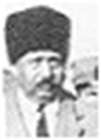




she has a knack for staying alive, that's for sure!
I missed out on my last half-season with uni thanks to the ol’ ‘rona, so looking forward to being able to play again sometime. Hopefully not a 25 year wait, mind!








- sorry, I might explain but will never apologise). This has grainy hand-held visuals, but you can hear him fine. It is from 2010, when he was 80 years old. He wasn't necessarily my brand of politics, but was a great figure and could sing, drink and played cricket. Can't say fairer than that! Bob Hawke, Solidarity Forever, 2010

